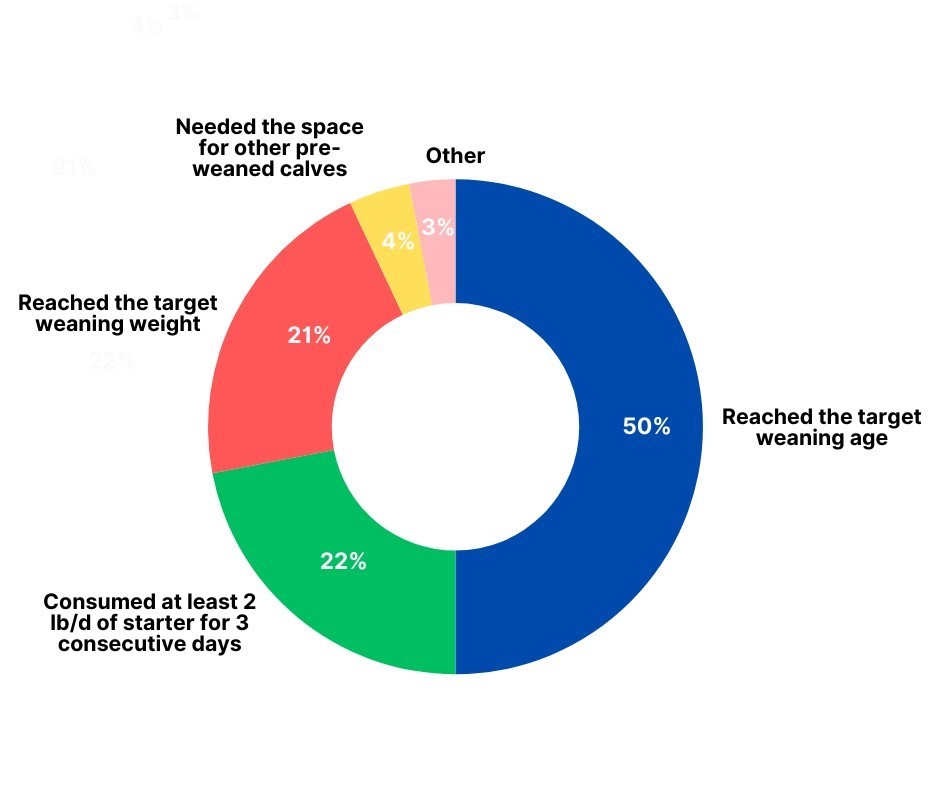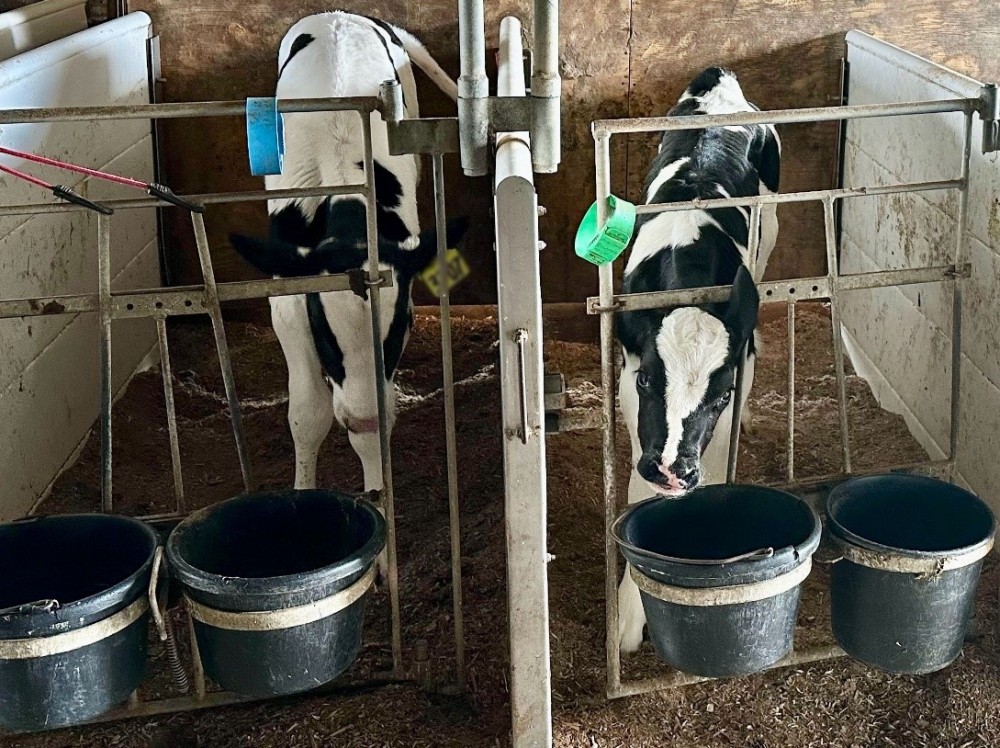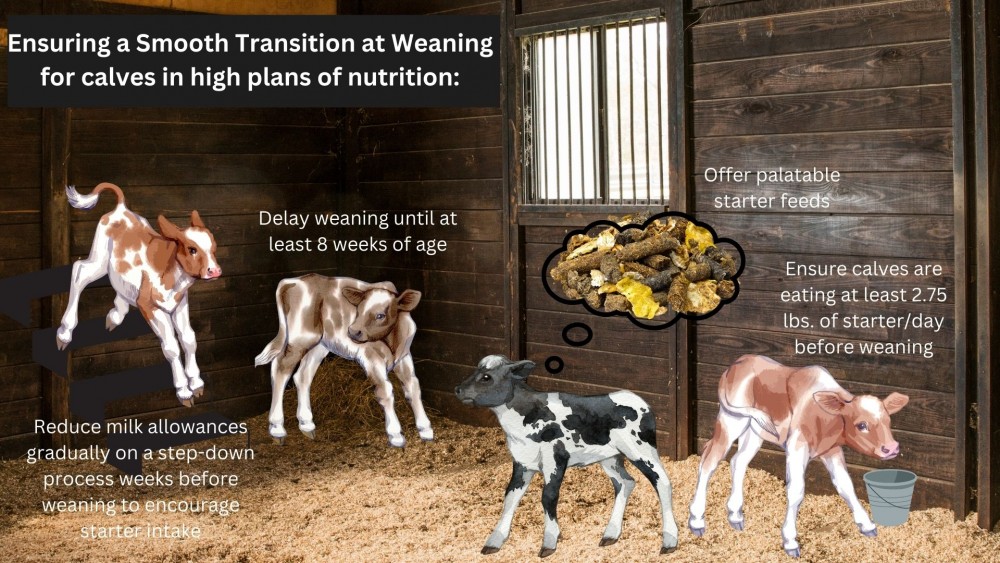Are your calves eating enough starter at weaning? by Camila Lage
Camila Lage, Dairy Management Specialist
Southwest New York Dairy, Livestock and Field Crops Program
Are your calves eating enough starter at weaning?
By Camila Lage, Dairy Management Specialist
Calf-rearing programs on farms have undergone significant changes in recent years. Traditionally, these programs aimed to reduce raising costs of replacement heifers by promoting early starter feed intake, providing calves with an average of 1.2 lb./d of milk solids (~ 4 quarts of whole milk daily), and weaning them at 4-6 weeks of age. However, research has shown that higher nutrition plans during the pre-weaning phase benefit animal health and welfare and can potentially boost future milk production (Soberon et al., 2012). Consequently, the industry has increased milk/milk replacer allowances to an average of at least 1.7 lb./d (~ 6 quarts of whole milk daily) and extended the pre-weaning phase to at least eight weeks of age. While this is a better practice regarding calf health and welfare, it presents a new challenge: preparing calves to transition from liquid to solid diets. This task requires careful planning and execution.
High liquid feeding plans can delay starter intake, and weaning calves that are not eating enough starters to supply all necessary nutrients to support desired gains often lead to growth slumps in the 2-3 weeks following weaning, which is economically unfavorable. Despite the high cost of nutrients offered at these ages, the most cost-effective growth occurs during the first six months of life. Feed efficiency (efficiency to convert the feed they consume into body weight gain or growth) can be as high as 60% until two months of age and around 30% right after weaning. Therefore, accruing 1 unit of BW at this stage is generally more economical than later in life (efficiency at 22 months of age is about 7%) (Bach et al., 2017).

Figure 1. Percentage of operations in the USA by primary factor used to determine when to wean heifers. Adapted from USDA/NAHMS 2014.
There is significant variation in weaning practices on dairy farms worldwide, with age being the primary criterion for weaning for most farmers in the USA (50.2%) (USDA, 2014). Over the past two decades, researchers have studied which weaning strategies best promote rumen development and growth while minimizing signs of hunger and distress. These strategies primarily focus on age at weaning and the duration of the weaning process. Here is a compilation of the four main points to consider when developing a weaning strategy for calves in high-nutrition programs.
1) Solid feed availability and quality: To promote solid feed intake before weaning, offering a highly palatable starter rich in fermentable carbohydrates is crucial, typically with a starch content ranging between 25-35%. The physical form of the starter also matters, with textured starters showing greater intake and average daily gains compared to other forms. While starters are more effective than forages in stimulating rumen development, there seem to be benefits of providing access to about 5% of chopped grass (~1 inch) alongside a starter, especially for calves eating pelleted starters, which can enhance feed intake, improve rumen function, and help calves digest post-weaning diets more efficiently (NASEM, 2021). For calves consuming liquid-feeding diets with more than 1.9 lb/d of solids (~ 8 quarts of milk/d), proving starters with crude protein contents of 22-25% of dry matter have shown to result in increased growth rates.
2) Age at weaning: Recently, a meta-analysis evaluating weaning practices for dairy calves observed positive effects in weaning calves at later ages, suggesting that early weaning should be avoided. The precise age at which the 'tipping point' occurs is unclear but weaning after 8 weeks of age appears to support superior average daily gains, especially if calves are receiving liquid diets higher than 1.7 lb of solids or 6 quarts of milk daily. According to the USDA, in 2014, 31.1% of farms in the USA were weaning their calves at 9 weeks or later.
3) Weaning methods: Reducing the allowance of liquid diet weeks before weaning facilitates a smooth transition to solid feed. According to literature findings, calves respond best to gradual weaning over a period of at least 10 days, with slow drops in volume over weeks being the most benefitial strategy. This approach, known as "step-down" weaning, is easier to implement with automated feeders but for farms manually feeding calves, a practical strategy involves breaking the pre-weaning feeding system into weeks and gradually reducing milk volume at each feeding three weeks before weaning, then halving the daily milk delivery one week before weaning (Bach et al., 2017). Some farms use color-coding systems or other creative methods to help them monitor the volumes calves should receive.
Despite limited research, dilution is a weaning method often used by farmers. In general, the consensus of the research in this topic is that calves receiving diluted milk during weaning consumed less starter during the weaning period than calves receiving lower volumes of liquid diet; however, there was no negative impact on growth, and there were some positive effects on behavior such as less vocalization (Walk et al., 2024). Further research is needed to compare dilution with other weaning methods.

Figure 2. Calves under a color-coding systems to help calf feeder monitor volume of liquid feed each calf should receive.
4) Starter intake at weaning: According to the NASEM (2021), calves should consume at least 2.75 lbs. of starter/day before weaning. If the farm aims to achieve a post-weaning average daily gain higher than 2.2 lbs./d, calves should ideally consume at least 4.0 lbs./d of starter before weaning (Bach at al., 2017). A recent article suggested that weaning based on concentrate intake rather than fixed ages or weights can improve performance (Walk et al., 2024). Still, only 21.5% of farms in the USA use this as a weaning criterion (USDA, 2014). Tracking starter intake is labor intensive and can be hard to implement on farms. Therefore, most farms continue to base their weaning programs on age or other criteria such as body weight. Nevertheless, starter intake at weaning can be used as a tool for farms to evaluate the success of weaning programs. If high rates of disease or low performance are being observed on the transition pen, measuring the starter intake of a sample of calves at weaning, together with BW at weaning and 2-3 weeks post-weaning, can help farms identify potential bottlenecks in order to tweak their weaning management.
Modern calf-rearing programs have evolved to prioritize higher levels of nutrition pre-weaning, aiming to improve growth, health and future productivity. However, transitioning calves from liquid to solid diets under these nutritional plans remains challenging and, if not managed correctly, can compromise calf performance after weaning. To ensure a smooth transition, key recommendations include:
- Offering palatable starter feeds (texturized preferred) and about 5% of calves intake as chopped grass (~1 inch) separate from starter;
- Delaying weaning until at least 8 weeks;
- Implementing gradual weaning methods (such as step-down), with slow drops of milk before final reduction of volume and frequency;
- Ensuring calves are eating at least 2.75 lbs. of starter/day before weaning.
REFERENCES:
USDA-NAHMS. 2014. Dairy cattle management practices in the United States, 2014. https://www.nmpf.org/first-2014-dairy-nahms-report-released/ accessed on 4/4/2024 at 1:04 pm
Welk, A., Neave, H.W. and Jensen, M.B., 2024. Invited review: The effect of weaning practices on dairy calf performance, behavior, and health-a systematic review. Journal of Dairy Science.
National Academies of Sciences, Engineering, and Medicine (NASEM). 2021. Nutrient Requirements of Dairy Cattle: Eighth Revised Edition. Washington, DC: The National Academies Press.
Bach, A., Khan, M.A. and Miller-Cushon, E.K., 2017. Calf transition: Managing and feeding the calf through weaning. In Pages 421-430 in Large Dairy Herd Management. Am. Dairy Sci. Assoc., Champaign, IL.
Soberon, F., Raffrenato, E., Everett, R.W. and Van Amburgh, M.E., 2012. Preweaning milk replacer intake and effects on long-term productivity of dairy calves. Journal of dairy science, 95(2), pp.783-793.

Upcoming Events
WEBINAR - Automated Milking Systems Efficiency: Balancing Focus on Individual Cows and System Optimization
May 8, 2024
Please join Cornell the SWNY team and MSU Extension for our talk with Dr. Pablo Silva Boloña on improving efficiency of Automated milking systems by focusing on milking settings for individual and group success.
Broiler Field Day at Sunny Cove Farm
June 6, 2024
Alfred Station, NY
Join us for a field day to explore broiler production, processing, and finances. Meghan Snyder of Sunny Cove Farm will be our host. She raises small batches of organic broilers, processing them on-farm under the 1,000 bird exemption.
Cornell Seed Growers Field Day
July 2, 2024
Ithaca, NY
Please Save the Date for the Cornell Seed Growers Field Day to be held the morning of July 2nd. The event will be held at the NYSIP Foundation Seed Barn, 791 Dryden Rd., Rt. 366, Ithaca, NY.
Announcements
No announcements at this time.





